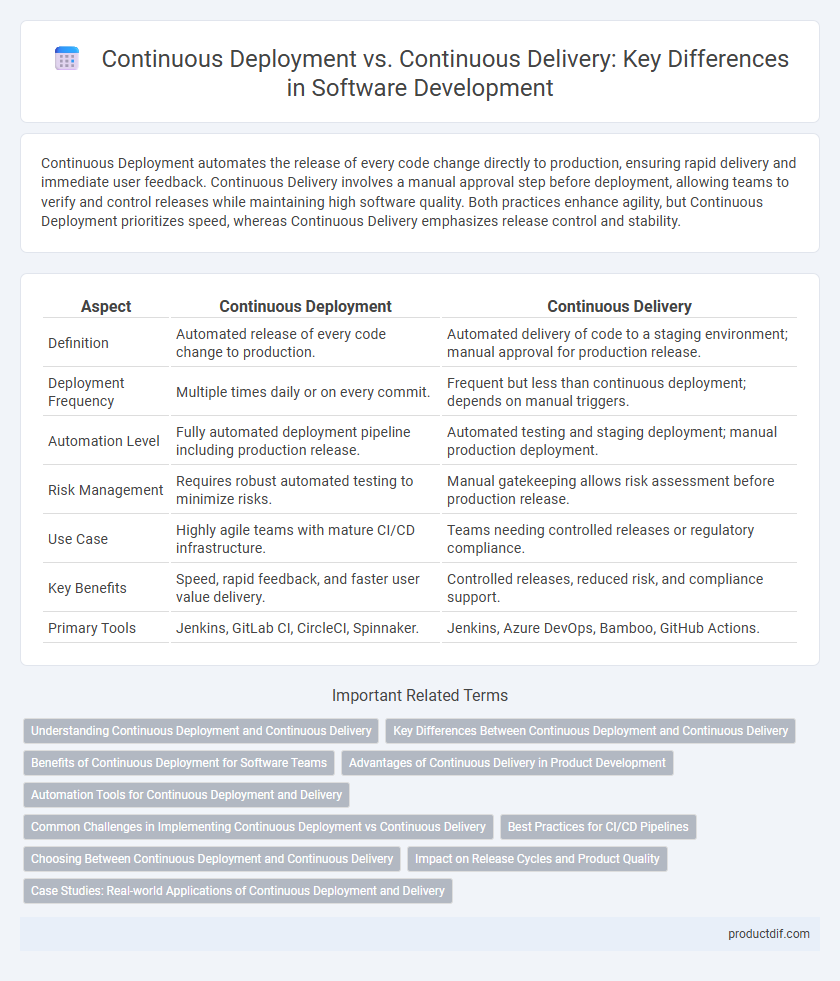Continuous Deployment automates the release of every code change directly to production, ensuring rapid delivery and immediate user feedback. Continuous Delivery involves a manual approval step before deployment, allowing teams to verify and control releases while maintaining high software quality. Both practices enhance agility, but Continuous Deployment prioritizes speed, whereas Continuous Delivery emphasizes release control and stability.
Table of Comparison
| Aspect | Continuous Deployment | Continuous Delivery |
|---|---|---|
| Definition | Automated release of every code change to production. | Automated delivery of code to a staging environment; manual approval for production release. |
| Deployment Frequency | Multiple times daily or on every commit. | Frequent but less than continuous deployment; depends on manual triggers. |
| Automation Level | Fully automated deployment pipeline including production release. | Automated testing and staging deployment; manual production deployment. |
| Risk Management | Requires robust automated testing to minimize risks. | Manual gatekeeping allows risk assessment before production release. |
| Use Case | Highly agile teams with mature CI/CD infrastructure. | Teams needing controlled releases or regulatory compliance. |
| Key Benefits | Speed, rapid feedback, and faster user value delivery. | Controlled releases, reduced risk, and compliance support. |
| Primary Tools | Jenkins, GitLab CI, CircleCI, Spinnaker. | Jenkins, Azure DevOps, Bamboo, GitHub Actions. |
Understanding Continuous Deployment and Continuous Delivery
Continuous Deployment automates the release process by deploying every code change directly to production without manual intervention, ensuring rapid delivery and immediate feedback. Continuous Delivery maintains a production-ready state but requires manual approval before deployment, balancing automation with controlled releases. Both practices enhance software quality and deployment frequency, but Continuous Deployment emphasizes speed and automation, while Continuous Delivery prioritizes stability and risk management.
Key Differences Between Continuous Deployment and Continuous Delivery
Continuous Deployment automates the release of every successful code change directly into production, ensuring rapid and frequent updates without manual intervention. Continuous Delivery ensures code changes are automatically tested and prepared for release but requires manual approval before deployment to production. The key difference lies in the final step: Continuous Deployment delivers changes immediately, while Continuous Delivery provides a controlled release process.
Benefits of Continuous Deployment for Software Teams
Continuous Deployment accelerates software release cycles by automatically deploying every code change that passes automated tests to production, enhancing rapid feedback and reducing time-to-market. It minimizes manual intervention, which reduces human errors and boosts deployment consistency across environments. Software teams benefit from increased agility, improved collaboration, and faster customer value delivery through constant, reliable updates.
Advantages of Continuous Delivery in Product Development
Continuous Delivery enhances product development by enabling faster and more reliable software releases through automated testing and deployment pipelines. It reduces risk by ensuring that code changes are always in a deployable state, allowing teams to quickly respond to market demands and user feedback. This practice improves collaboration between development and operations teams, leading to higher software quality and increased customer satisfaction.
Automation Tools for Continuous Deployment and Delivery
Automation tools such as Jenkins, GitLab CI/CD, and CircleCI enable seamless integration and continuous deployment by automating testing, build, and release processes. Continuous Delivery leverages tools like Spinnaker and Argo CD to automate staging and manual approval workflows, ensuring reliable production releases. Kubernetes and Docker support both practices by orchestrating containerized applications, enhancing scalability and deployment speed.
Common Challenges in Implementing Continuous Deployment vs Continuous Delivery
Common challenges in implementing Continuous Deployment and Continuous Delivery include managing automated testing reliability, handling deployment failures without affecting user experience, and ensuring seamless integration with existing development workflows. Continuous Deployment demands more robust automation and monitoring to prevent faulty releases, while Continuous Delivery requires maintaining a manual approval process that can slow down delivery speed. Both approaches face difficulties in aligning team collaboration and maintaining consistent environment configurations across development, staging, and production.
Best Practices for CI/CD Pipelines
Implementing best practices for CI/CD pipelines requires defining clear deployment criteria to distinguish between Continuous Deployment and Continuous Delivery, ensuring automated testing and monitoring at every stage to maintain code integrity. Integrating feature toggles and canary releases enhances risk management by allowing incremental rollouts and quick rollback options. Leveraging infrastructure as code (IaC) and maintaining a single source of truth improves consistency and repeatability in deployment processes across environments.
Choosing Between Continuous Deployment and Continuous Delivery
Choosing between Continuous Deployment and Continuous Delivery depends on the organization's risk tolerance, release frequency, and automation maturity. Continuous Deployment offers seamless, automatic releases to production after passing tests, accelerating feedback but requiring robust monitoring and rollback mechanisms. Continuous Delivery ensures code is always production-ready but triggers manual deployment approval, balancing speed with control and compliance needs.
Impact on Release Cycles and Product Quality
Continuous Deployment automates the release process by deploying every code change directly to production, significantly accelerating release cycles and enabling rapid user feedback. Continuous Delivery, while ensuring code is always in a deployable state, involves manual approval before production release, offering greater control at the expense of slightly longer release cycles. Both approaches enhance product quality through automated testing and integration, but Continuous Deployment demands more rigorous monitoring and rollback strategies to maintain stability.
Case Studies: Real-world Applications of Continuous Deployment and Delivery
Case studies of Continuous Deployment and Continuous Delivery reveal significant improvements in release frequency and software quality across industries such as finance, e-commerce, and telecommunications. Netflix's Continuous Delivery pipeline enables rapid feature releases with automated quality gates, reducing deployment time from weeks to hours while maintaining platform stability. In contrast, Etsy's Continuous Deployment system achieves multiple daily releases by integrating automated testing and canary deployments, minimizing downtime and accelerating user feedback loops.
Continuous Deployment vs Continuous Delivery Infographic

 productdif.com
productdif.com